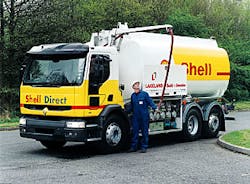Shell pilots safer road tanker design
New features on Shell's prototype tanker for delivering to smaller customers include a pneumatic hose boom that can be swung out high above obstacles and a bottom-loading and metering system so drivers do not have to climb on top to take dipstick readings. Photo courtesy of Shell U.K.Shell U.K. Ltd. has begun using a prototype road tanker designed to make fuel deliveries to small customers quicker and safer.
The tanker was developed for the commercial distributors' market by Lakeland Tankers Ltd., Redditch, U.K., along with Shell and motor industry firms Renault (U.K.) Ltd., Alfo Haar (U.K.) Ltd., Benfell's Ltd. and BH Sala.
The Shell Commercial unit of Shell U.K. delivers fuel and oil products to smaller customers, including private residences. Often the customer's premises are in remote spots or are difficult to gain access to, and sometimes fuel tanks are positioned out of easy reach.
Shell said these factors increase the potential for accidents and can slow down the delivery process, reducing the number of deliveries per day. The 26 metric ton prototype tanker has a number of new features to overcome these problems.
Innovative features include front and rear sonar sensors, closed circuit television cameras, a swiveling and rising hose boom, a dry line with hose end nozzle shut-off facility, electronic dipsticks, and a unique tanker top fall-arrest system that is being tested for fitting to existing tankers.
These are intended to prevent driver's blind spots and product spillages and to increase the speed and cost effectiveness of each delivery. The prototype will join Shell's current 200-vehicle fleet for evaluation.
Mike Hogg, Shell U.K.'s distributor manager, said: "We identified the potential to enhance our deliveries further by designing the 'ideal' tanker. I hope that others in the industry will follow our lead and look at introducing some of these measures into their own fleets."
Copyright 1999 Oil & Gas Journal. All Rights Reserved.
